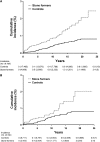Urolithiasis and the risk of ESRD
- PMID: 22745275
- PMCID: PMC3430957
- DOI: 10.2215/CJN.03210312
Urolithiasis and the risk of ESRD
Abstract
Background and objectives: The contribution of urolithiasis, if any, to the development of ESRD is unclear.
Design, setting, participants, & measurements: All stone formers in Olmsted County, Minnesota, first diagnosed between 1984 and 2008 were identified by diagnostic codes with up to four controls matched on age and sex. Charts were reviewed to validate symptomatic stone formers in a random subset. Incident ESRD events were identified by the US Renal Data System.
Results: Altogether, 51 stone formers and 75 controls developed ESRD among 6926 stone formers and 24,620 matched controls followed for a mean of 9 years. Stone formers had an increased risk of ESRD after adjusting for diabetes, hypertension, dyslipidemia, gout, and CKD (hazard ratio: 2.09; 95% confidence interval: 1.45-3.01). This increased risk of ESRD remained in the subset of 2457 validated symptomatic stone formers (hazard ratio: 1.95; 95% confidence interval: 1.09-3.49). The attributable risk of ESRD from symptomatic urolithiasis was 5.1% based on a prevalence of 5.4% for stone formers. For stone formers versus controls who developed ESRD, there was an increased likelihood of past hydronephrosis (44% versus 4%), recurrent urinary tract infections (26% versus 4%), acquired single kidney (15% versus 3%), neurogenic bladder (12% versus 1%), and ileal conduit (9% versus 0%), but not diabetes (32% versus 49%) or hypertension (44% versus 52%).
Conclusions: Symptomatic stone formers are at increased risk for ESRD independent of several cardiovascular risk factors. Other urological disease is relatively common among stone formers who develop ESRD.
Figures

References
-
- Gillen DL, Worcester EM, Coe FL: Decreased renal function among adults with a history of nephrolithiasis: A study of NHANES III. Kidney Int 67: 685–690, 2005 - PubMed
-
- Vupputuri S, Soucie JM, McClellan W, Sandler DP: History of kidney stones as a possible risk factor for chronic kidney disease. Ann Epidemiol 14: 222–228, 2004 - PubMed
Publication types
MeSH terms
Grants and funding
LinkOut - more resources
Full Text Sources
Medical
Miscellaneous

